Featured Comment:
“Thank you for this wonderful recipe! I used your gyoza wrapper recipe and also the shrimp filling…was a beautiful treat for a small dinner party appetizer! The panfrying and then steaming turned out perfectly browned bottoms and soft tops!”
– radhaks
What is Prawn Gyoza?
Gyoza, or potstickers in English, is a famous dumpling dish that originally comes from China. This dish had a big impact on Japan during the Showa period (1926-1989), drawing inspiration from the Chinese jiaozi.
But in China, the preferred version is sui-gyoza (boiled), which is very different from the pan-fried dumplings that are so popular in Japan. What makes gyoza special is how they’re defined: “dumplings crafted from flour and filled with various ingredients.” This broad framework allows for lots of different shapes and fillings, which vary from country to country.
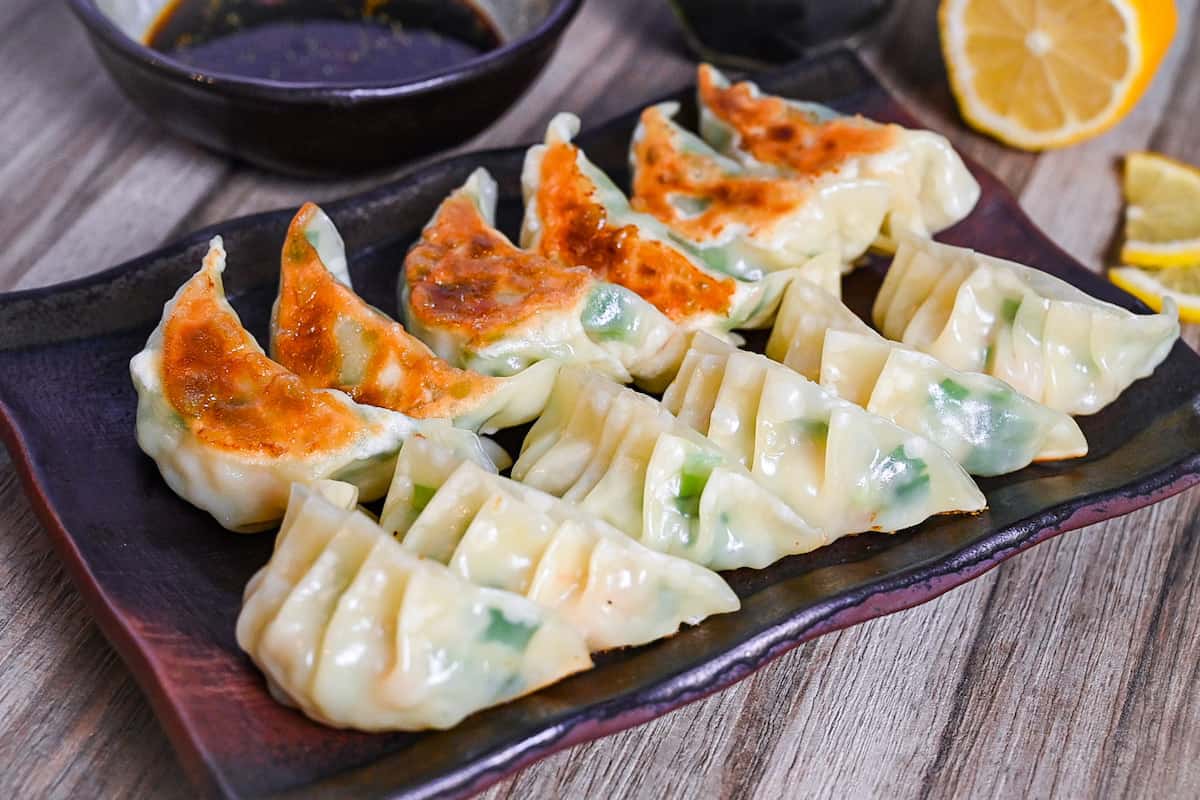
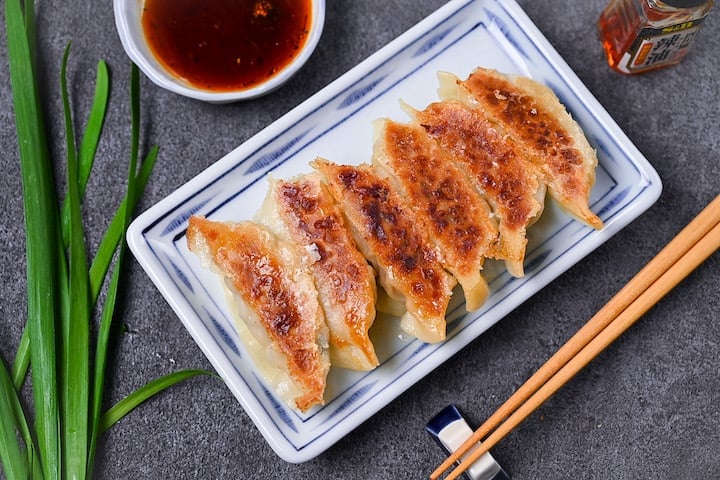
The standard pan-fried gyoza in Japan is meat gyoza, traditionally stuffed with ground pork and vegetables. It could be said that prawn gyoza can be made by simply substituting the pork filling with shrimp. However, in Japan, “shrimp dumplings” are often made with a combination of both pork and shrimp for easier wrapping and added flavor.
Despite this, the prawn gyoza recipe I will introduce here does not use any pork at all, only plenty of shrimp!
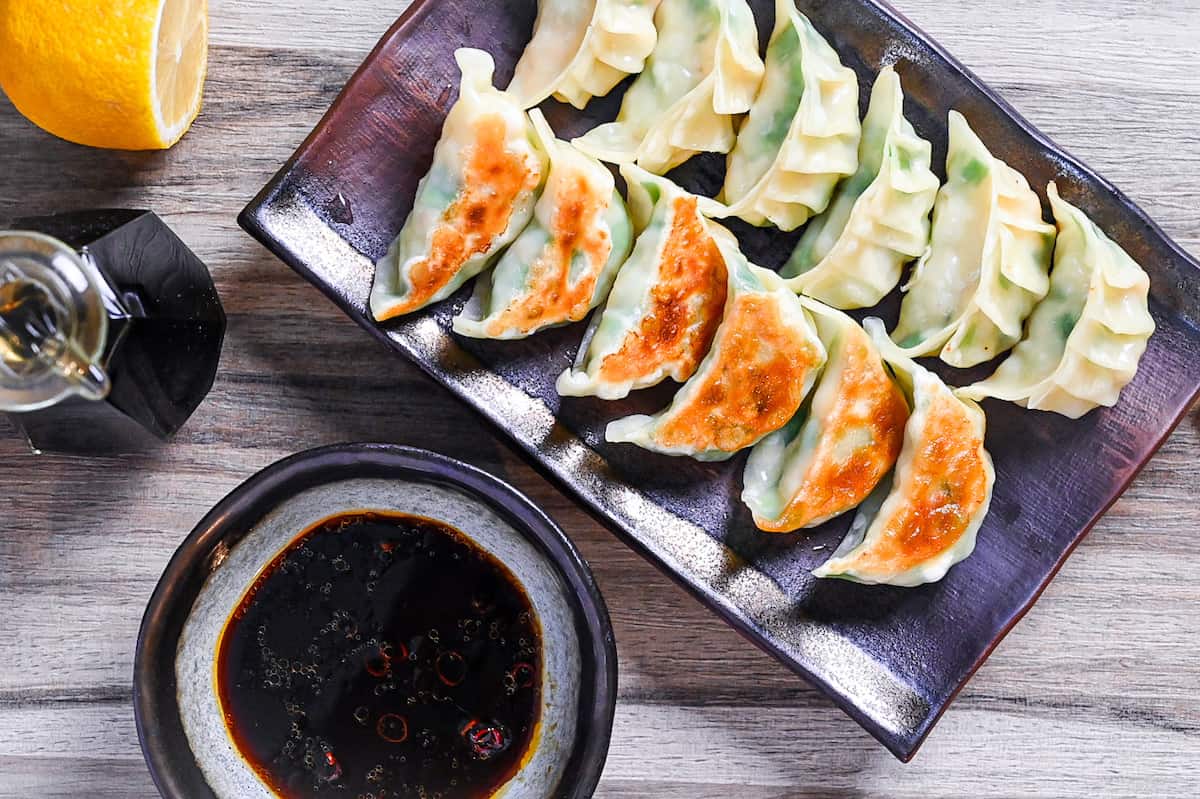
The Ultimate Preparation Guide
The beauty of creating gyoza at home is the fact that you are involved in each and every stage of making—from crafting the gyoza wrapper to mixing the filling, pan-frying, and even creating your dipping sauce. The magic of gyoza lies in its incredible flexibility; the final dish can dramatically vary based on your chosen preparation method.
I’ll guide you through each step in the upcoming section, sharing personal recommendations from my kitchen experiments.
Choosing the Right Gyoza Wrapper
Let’s begin by focusing on the humble gyoza wrapper. These wrappers are a staple in every supermarket in Japan, but they may not be as readily available in certain countries.
If you want to start with a commercially available wrapper, you’ll find that most of them generally range from 8.5 to 9.5 cm in diameter. I highly recommend opting for the larger 9.5 cm size. Not only does it make the wrapping process a breeze, but it also allows you to envelop the same amount of filling with fewer wrappers which is more time efficient!
Don’t worry if you can’t locate these wrappers at your local supermarket—you can always step into the shoes of a seasoned artisan and make your own! Crafting gyoza wrappers is as straightforward as it gets; armed with cake flour, strong flour, water, and salt, you’re all set.
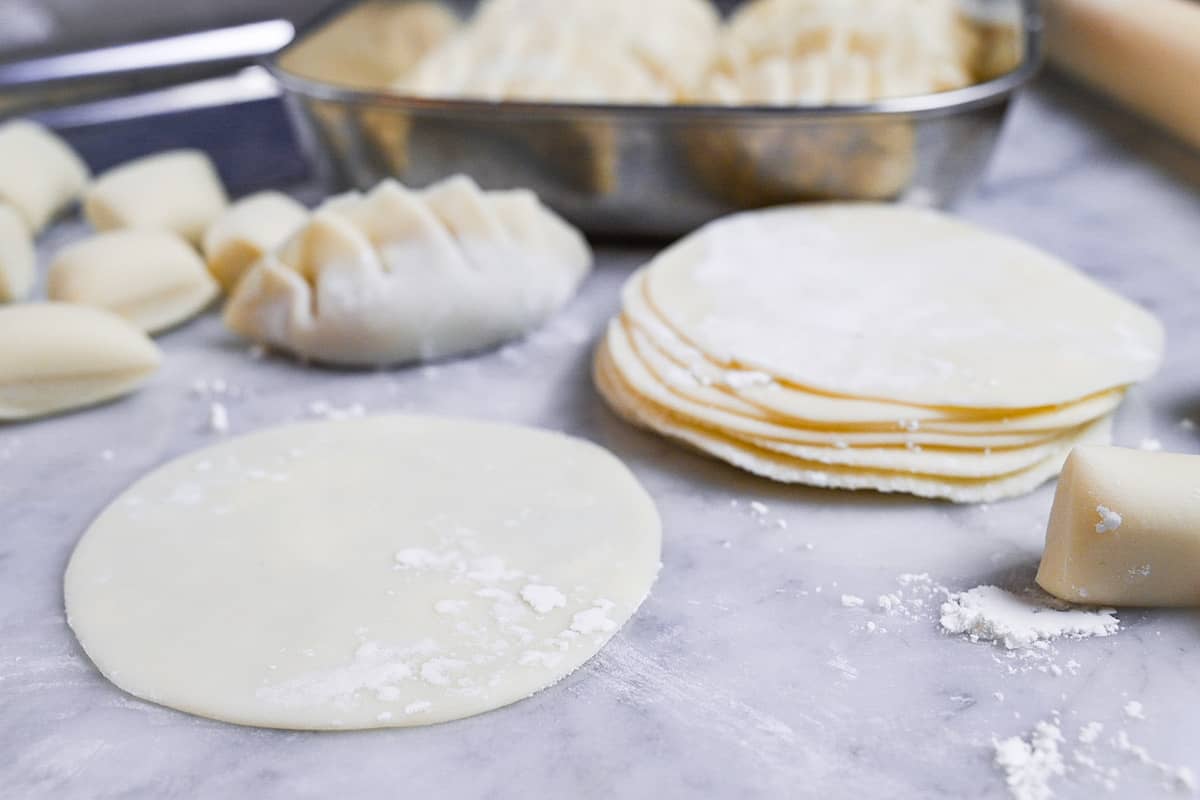
For those ready to take on this challenge, check out my recipe for homemade dumpling wrappers. Are you ready to add your personal touch to your gyoza?
If you want to go extra wild, you can even add some experimental colors and seasonings to make your gyoza totally unique. Below you can see a picture of my black gyoza wrappers I made with squid ink. Other options include matcha powder (green), turmeric (yellow) or even betroot juice (pink) just to name a few. Have fun with it!
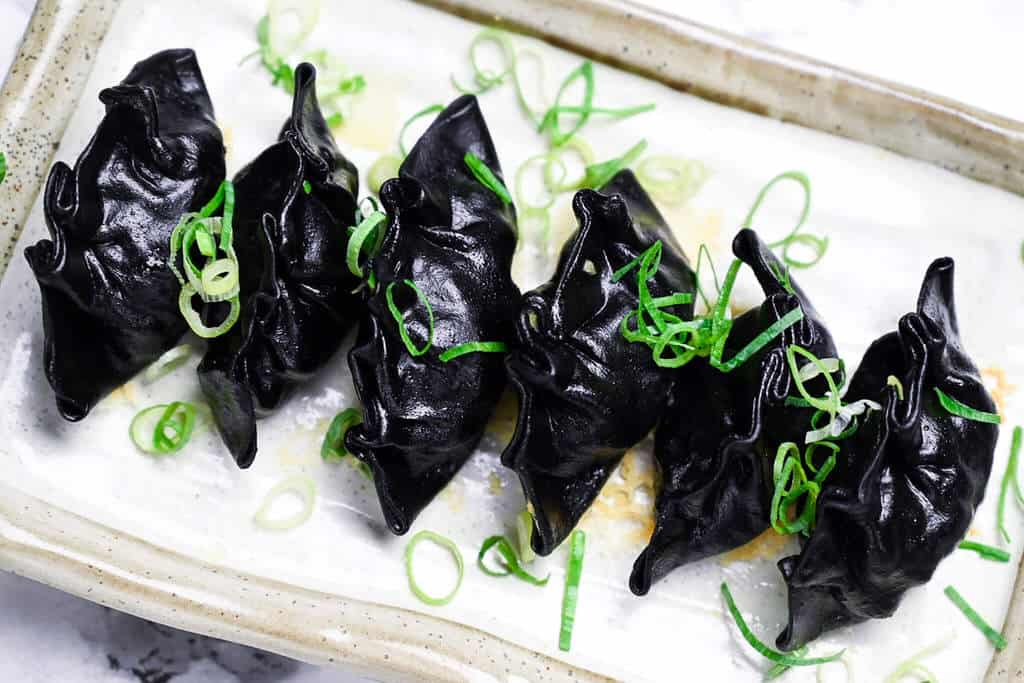
Shaping Gyoza into a Half-Moon
Next, we tackle the shape of the dumpling—the iconic half-moon shape that makes gyoza so instantly recognizable. If you’re new to wrapping dumplings, this might seem daunting, but trust me, once you get into the rhythm, it becomes second nature.
As someone who isn’t naturally gifted in crafts requiring dexterity, I assure you, I learned the ropes fairly quickly. And once I did, wrapping those dumplings was a breeze.
Now, let me share the simplest way to wrap those dumplings neatly—a method that’ll make you feel like a professional in no time. Let’s dive into the details.
- The ideal amount of folds – The number of folds in the gyoza depends on the width of the top skin fold. In my experience, the easiest to wrap is four or five; six requires a little more work because the width of the fold must be much finer. If you wrap the gyoza with the same number, they will look more consistent when fried together.
- The amount of filling – One of the most important things to remember is the fillings. If it is too much, it may stick out from the edges during wrapping, or the wrapper may tear. Basically, for a standard-sized wrapper, about a teaspoon is a safe amount.
- Spread the filling – It is recommended that the dumpling filling be spread on a wrapper rather than placed in a heap. This makes it less likely to be overfilled and easier to wrap neatly.
Place the wrapper on your palm and spread 1 tbsp of mixture in the middle.
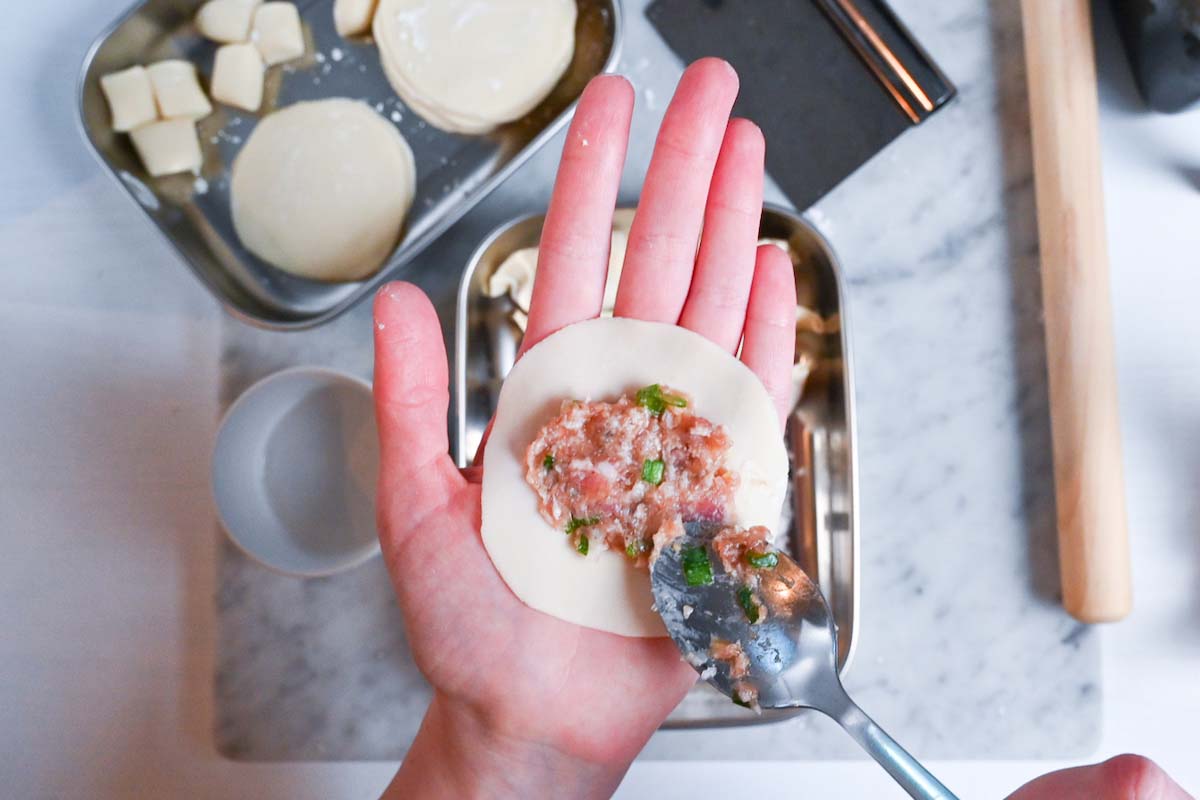
Use a small amount of water to wet the edges. This will seal your gyoza and prevent leaks.
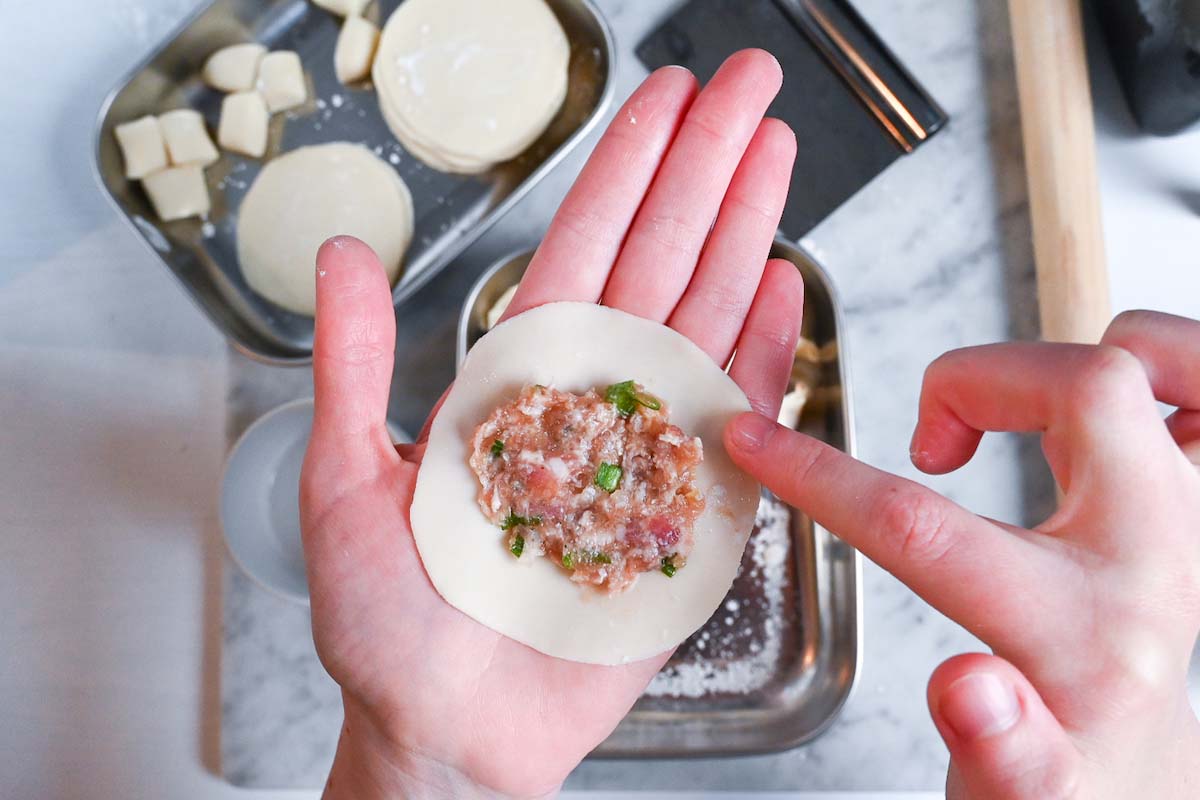
Start the folding process by pinching one corner first.
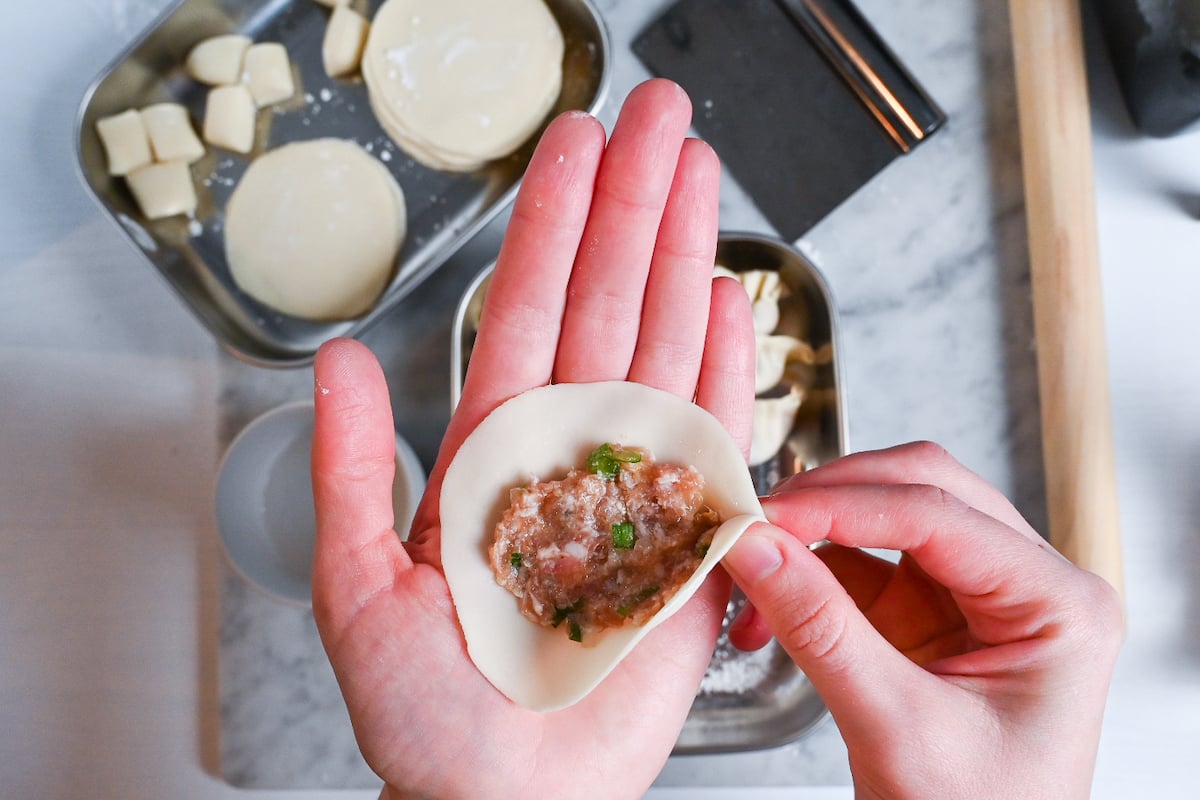
From there, continue to use your thumbs to space out and press down each pleat until you reach the end of the wrapper. Press down firmly to seal.

The Secret to Pan Fried Gyoza: Golden Brown and Crispy
Pan-frying gyoza that boasts a perfect crispy finish involves a few clever tricks. For instance, in the case of my pork dumpling recipe, I added a bit of flour to the water in the pan can result in beautiful “winged” gyoza (hane gyoza).
For this time, I’ll share a different secret technique—”adding boiling water instead of cold water”. This method gives the dumplings a soft, plump fold and a wonderfully crispy surface. I prefer using boiling water because it doesn’t drastically lower the temperature of the pan, ensuring an even and gorgeous sear.
A bonus? When you pour boiling water into the mix, the gluten in the wheat immediately clumps together, preventing the dumpling from sticking to each other. All you need is boiled water, so please give it a try!
Gyoza Dipping Sauces
Last but certainly not least, let’s discuss the dipping sauce that takes our gyoza to the next level. The most popular choice is a zingy concoction of soy sauce, vinegar, and raayu (sesame oil-based chili oil). If you’re fond of the traditional route, you can check out my classic gyoza dipping sauce recipe right here.
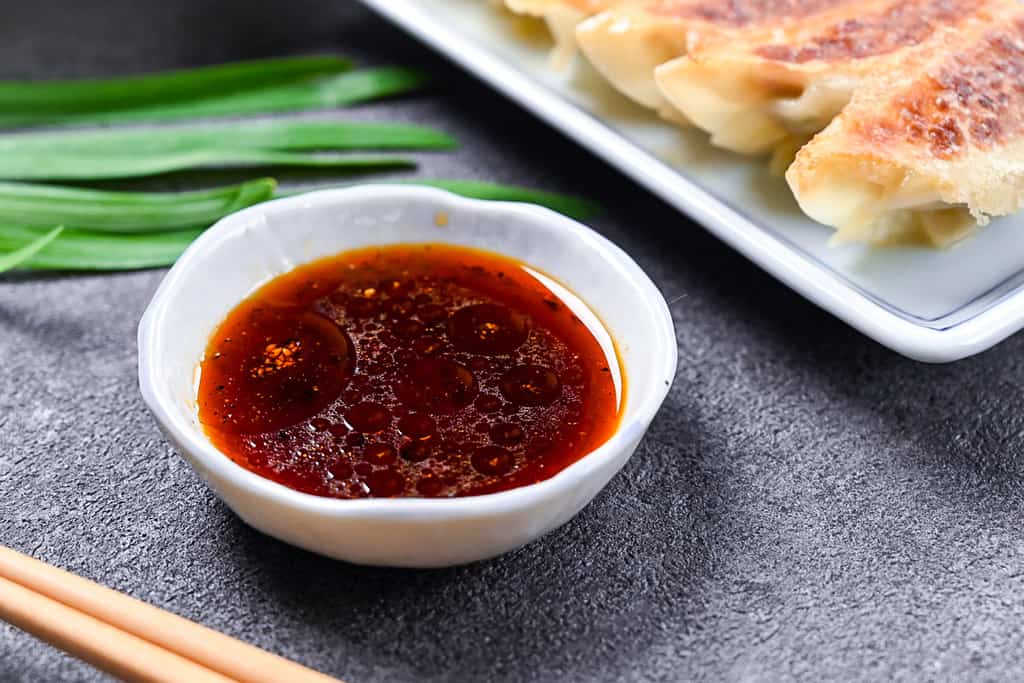
For our prawn gyoza this time, though, we’ve opted to pair it with a ponzu sauce. Its tangy, citrusy notes harmonize perfectly with the delicate flavor of shrimp.
Remember, the world of gyoza dipping sauces is as diverse as your imagination allows. Feel free to experiment with various condiments and create a signature sauce that suits your taste.
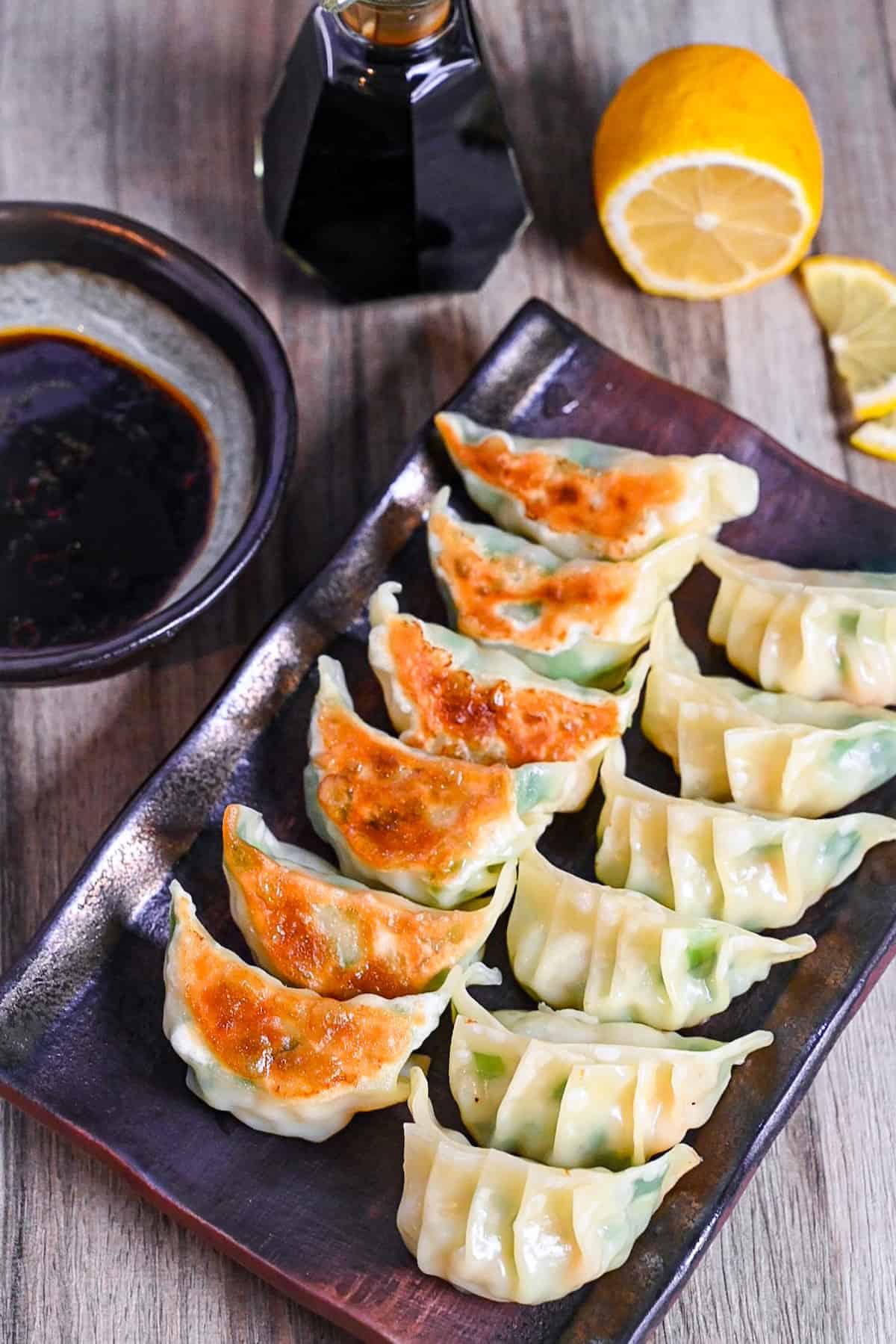
Visual Walkthrough & Tips
Here are my step-by-step instructions for how to make Shrimp Gyoza at home. For ingredient quantities and simplified instructions, scroll down for the Printable Recipe Card below.
If you prefer to watch the process in action, check out my YouTube video of this Shrimp Gyoza recipe for a complete visual walkthrough!
Deshell, devein and wash your prawns before using a knife to finely chop them until they reach a paste-like consistency. You don’t need to be too thorough here. We use a knife (instead of a food processor) so that the texture is a little chunky.
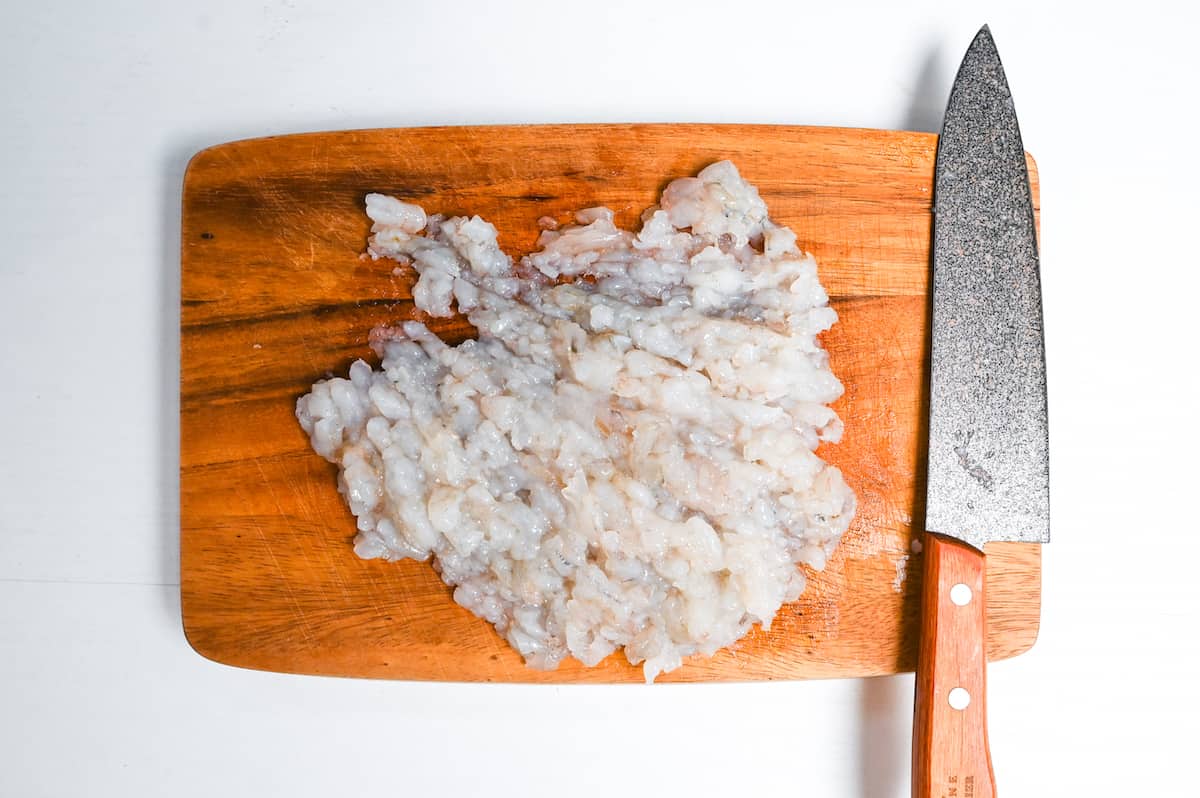
Transfer the prawns to a mixing bowl and add black pepper, soy sauce, sake, grated garlic, grated ginger, scallop stock powder, cornstarch, garlic chives and white onion. Mix until the ingredients are evenly distributed.

Take a gyoza wrapper and place it on your flattened palm. Add 1 tbsp of filling to the center and spread it evenly, leaving a finger-width border around the edge. Lightly wet the edge with cold water.
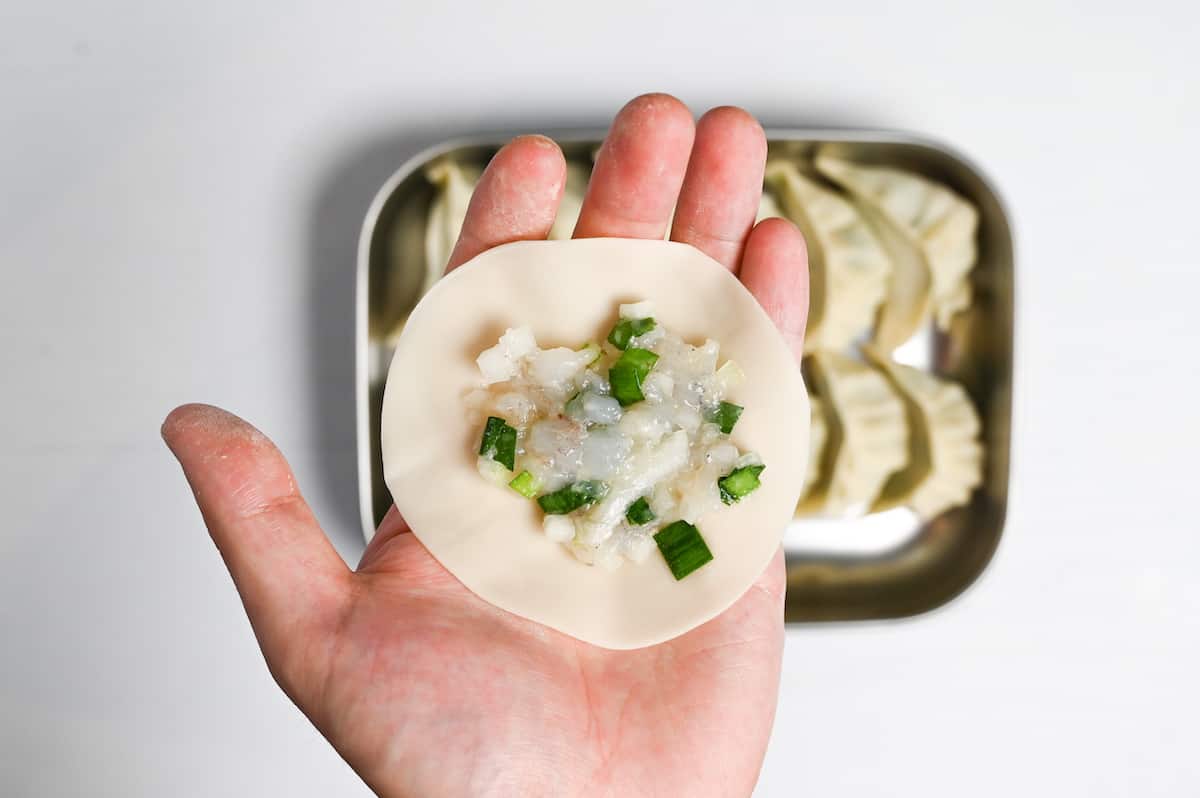
Fold the wrapper in half but don’t let the edges touch yet. Pinch one corner to start the pleat.
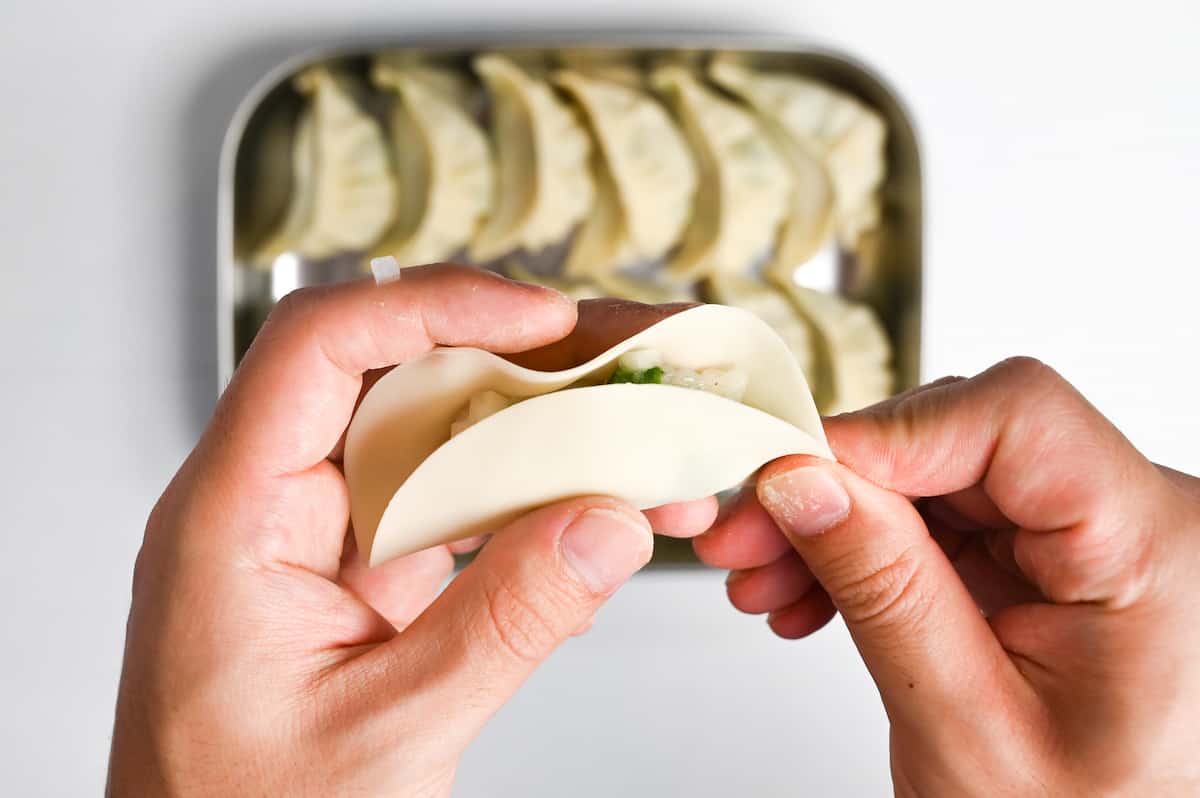
Make a small fold and press it down to make another pleat. Continue until the gyoza is sealed.
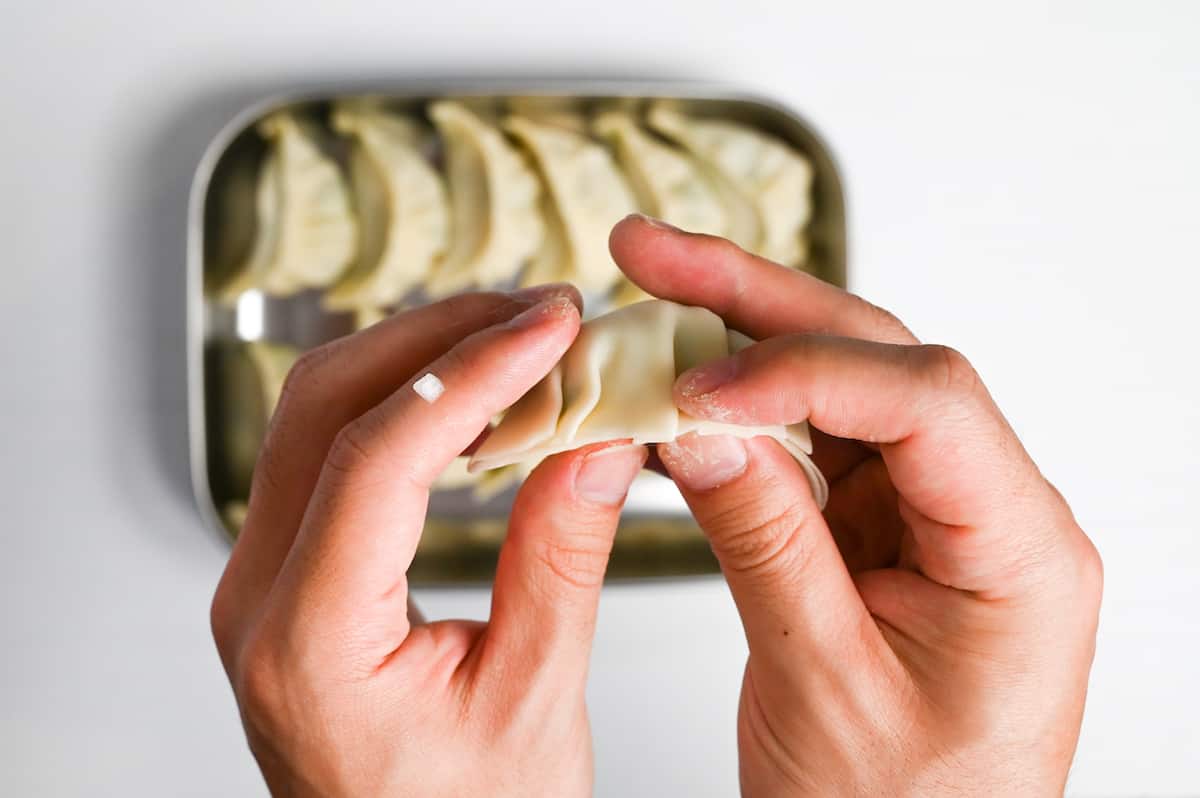
Press the pleats one last time to secure them.
Heat a frying pan on medium and once hot, add the cooking oil. Place the gyoza with the base flat to the bottom of the pan. Fry until golden underneath. While you wait, boil some water.
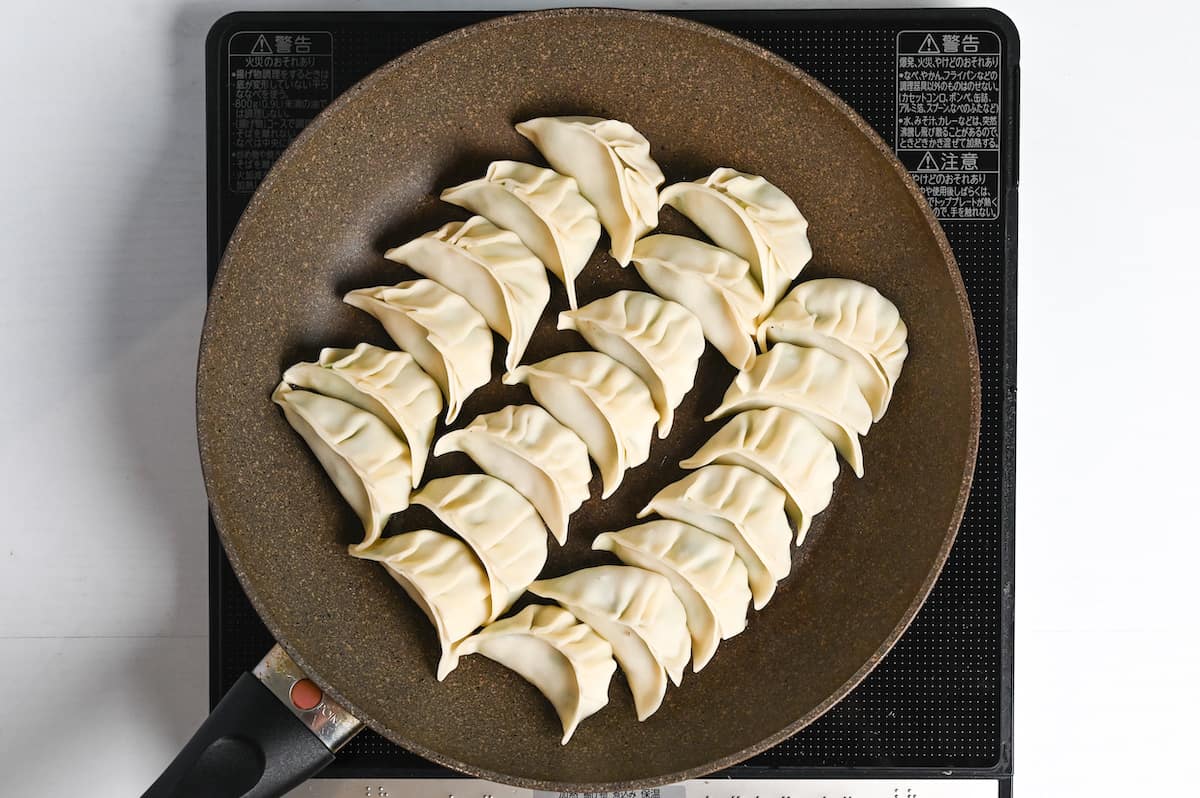
Once the underneath is browned, pour the boiled water around the pan and place a lid on top. Leave the gyoza to cook in the steam until the water has almost disappeared.
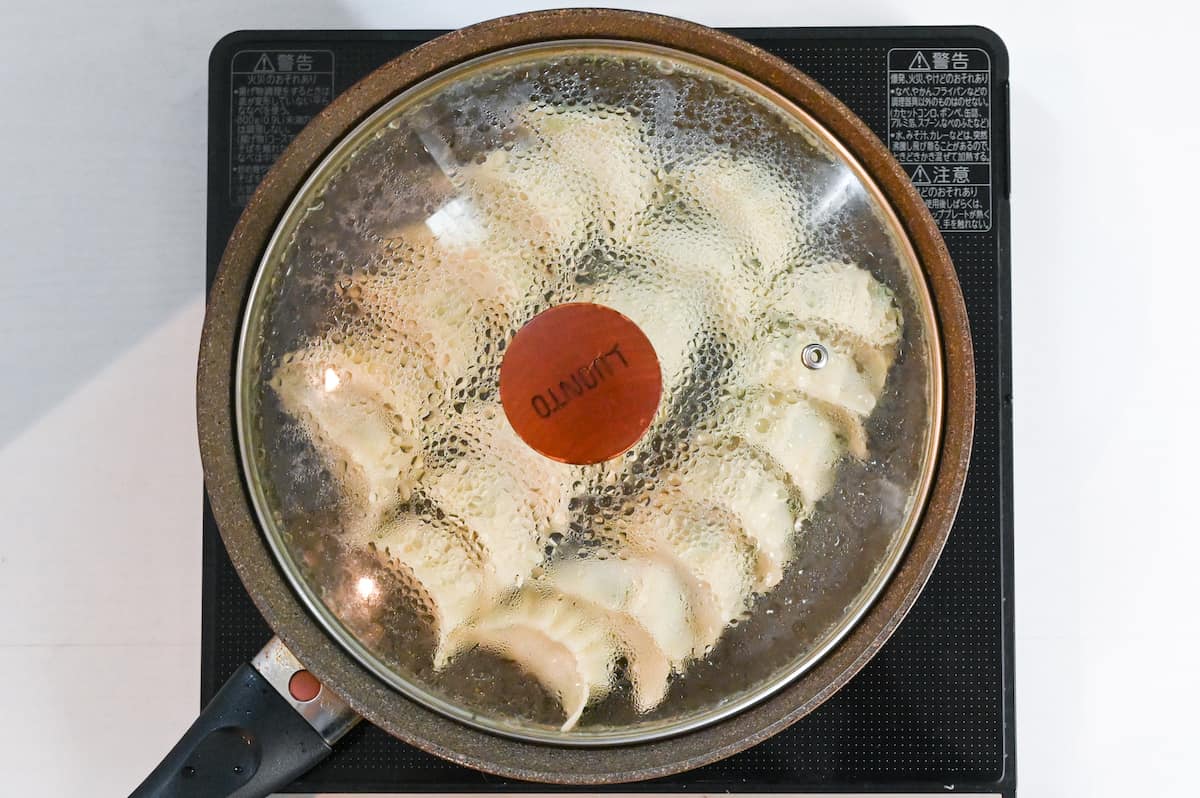
Once the water is almost gone, remove the lid. Allow the water to evaporate completely and then remove the pan from the heat.
Mix ponzu sauce, soy sauce, sesame oil and chili oil in a small bowl. If you want it a bit spicier, feel free to add some chopped chilies.
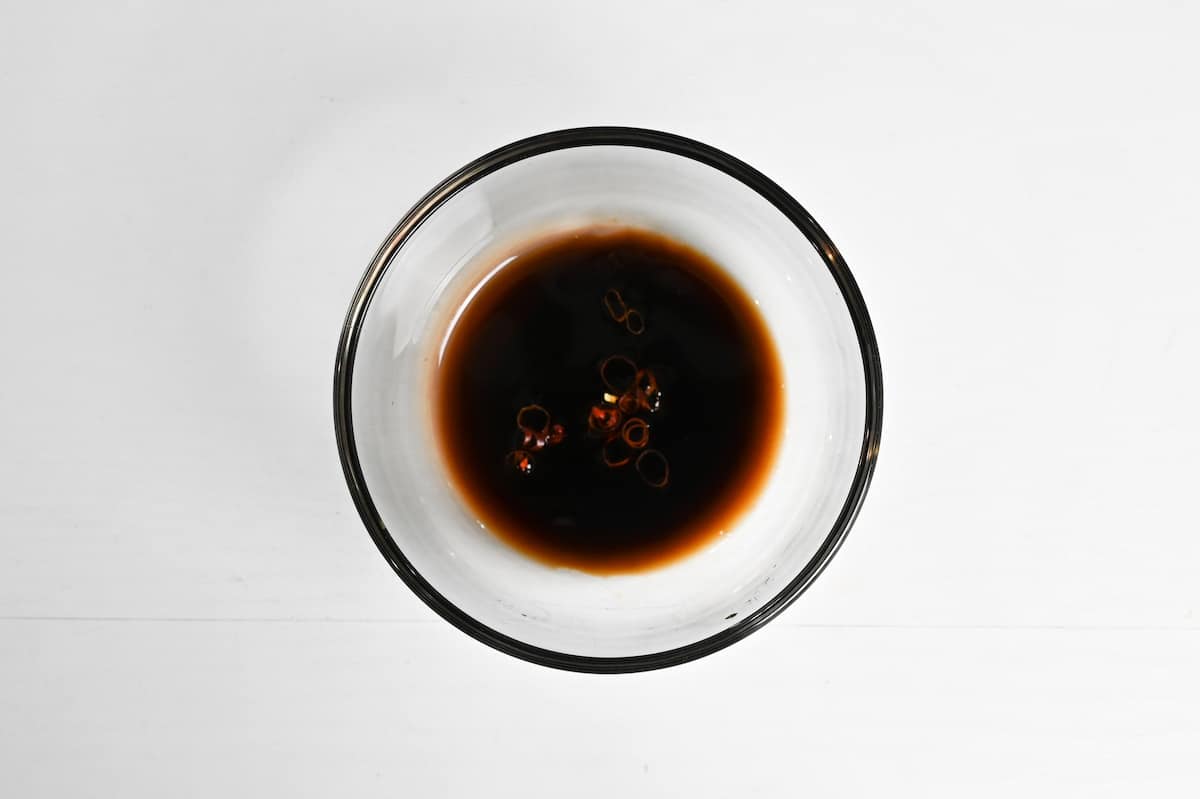
Flip the gyoza onto a serving plate and squeeze some lemon juice over the top.
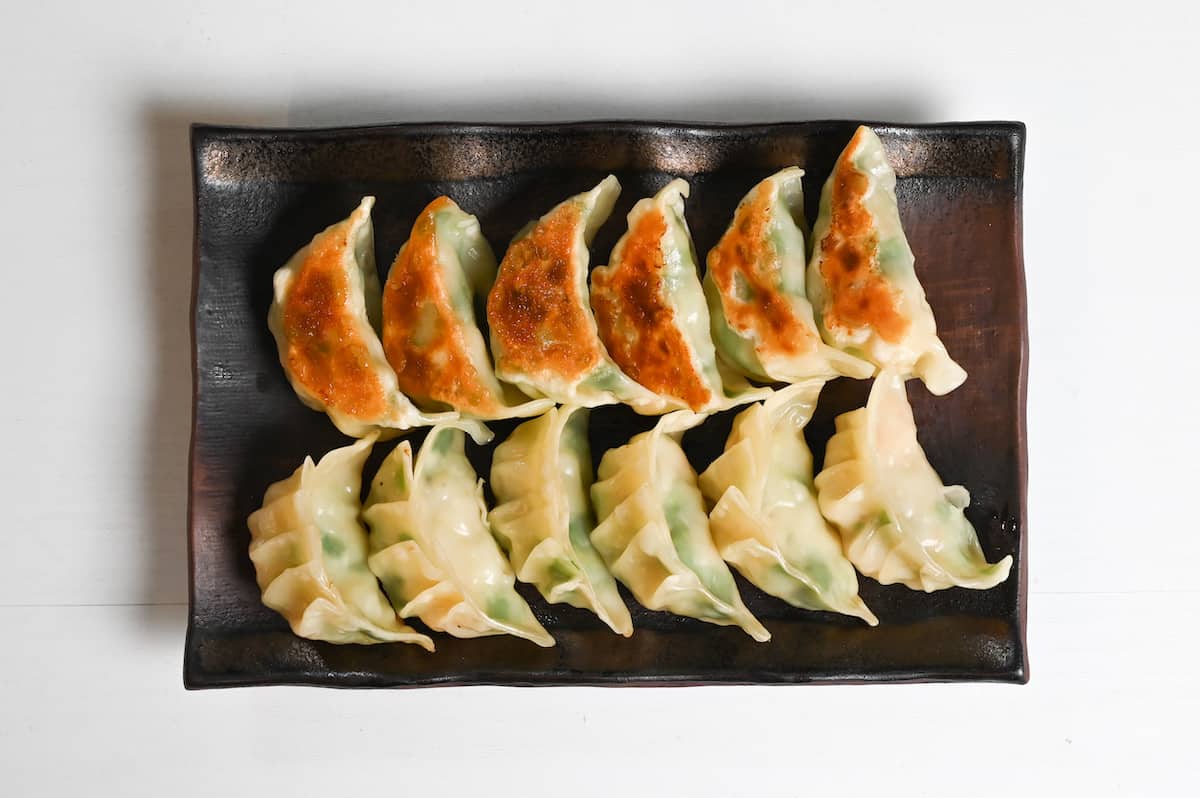
Serve with your homemade dipping sauce and enjoy!
Jump to Full Recipe MeasurementsI hope you enjoy this Shrimp Gyoza recipe! If you try it out, I’d really appreciate it if you could spare a moment to let me know what you thought by giving a review and star rating in the comments below. It’s also helpful to share any adjustments you made to the recipe with our other readers. Thank you!
More Gyoza Recipes
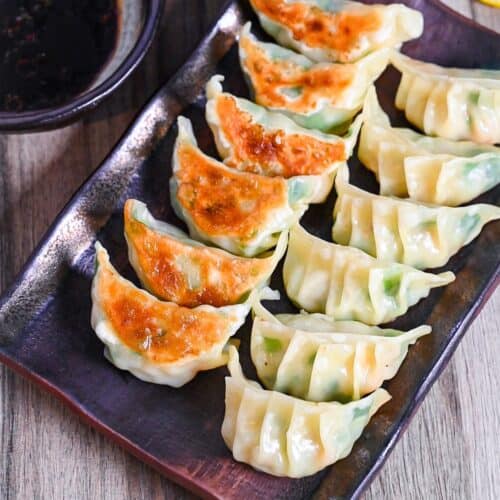
Pan-Fried Prawn Gyoza (Shrimp Potstickers)
Equipment
- Steel Mixing Bowls
Ingredients
- 200 g shrimp
- ⅛ tsp ground black pepper
- 1 tsp Japanese soy sauce (koikuchi shoyu)
- 1 tbsp sake
- 3 cloves grated garlic or garlic paste
- 1 tsp grated ginger root or ginger paste
- 1 tsp scallop stock powder or chicken/vegetable bouillon powder
- ½ tbsp cornstarch
- 30 g garlic chive(s) finely chopped
- 50 g onion finely diced
- 20 gyoza wrappers
- 1 tbsp cooking oil
- 150 ml freshly boiled water
- lemon juice to drizzle – optional
Sauce
- 1 tbsp ponzu sauce
- 1 tsp Japanese soy sauce (koikuchi shoyu)
- ½ tsp toasted sesame oil
- ¼ tsp chili oil (rayu) (rayu) optional
- dried red chili pepper finely chopped – optional
My recommended brands of ingredients and seasonings can be found in my Japanese pantry guide.
Can’t find certain Japanese ingredients? See my substitution guide here.
Instructions
- Use a knife to finely chop 200 g shrimp until it reaches a paste-like constency. (Feel free to leave some small chunks in there for extra texture.)

- Add the shrimps to a mixing bowl along with ⅛ tsp ground black pepper, 1 tsp Japanese soy sauce (koikuchi shoyu), 1 tbsp sake, 3 cloves grated garlic, 1 tsp grated ginger root, 1 tsp scallop stock powder, ½ tbsp cornstarch, 30 g garlic chive(s) and 50 g onion. Mix until all the ingredients are evenly distributed.

- Hold a gyoza wrapper in you palm and add 1 tbsp of the filling. Spread it evenly over the wrapper leaving a border around the edge.

- Damped the edge with water and fold the wrapper in half (without letting the sides touch yet). Pinch one corner to start the pleat.

- Fold and press to make the pleats until the gyoza is sealed.

- Heat a frying pan on medium and add 1 tbsp cooking oil. Once hot, place the gyoza in the pan with the flat facing down and fry until the bottoms are browned (approx 3-5 minutes).

- Once browned, pour 150 ml freshly boiled water around the gyoza and place a lid on top. Cook until the liquid is almost gone and then remove the lid.

- Continue to cook until the liquid is completely gone and then remove the pan from the heat.

- Mix 1 tbsp ponzu sauce, 1 tsp Japanese soy sauce (koikuchi shoyu), ½ tsp toasted sesame oil and ¼ tsp chili oil (rayu) in a small bowl. For an extra kick, feel free to add some chopped dried red chili pepper.

- Flip the gyoza onto a serving plate, drizzle with lemon juice and enjoy with your homemade dipping sauce!

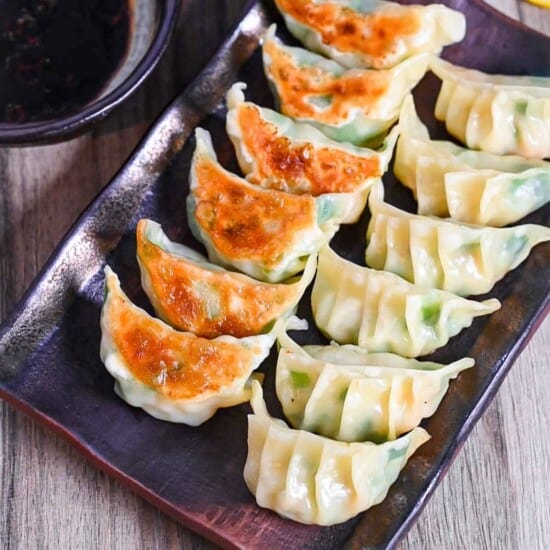




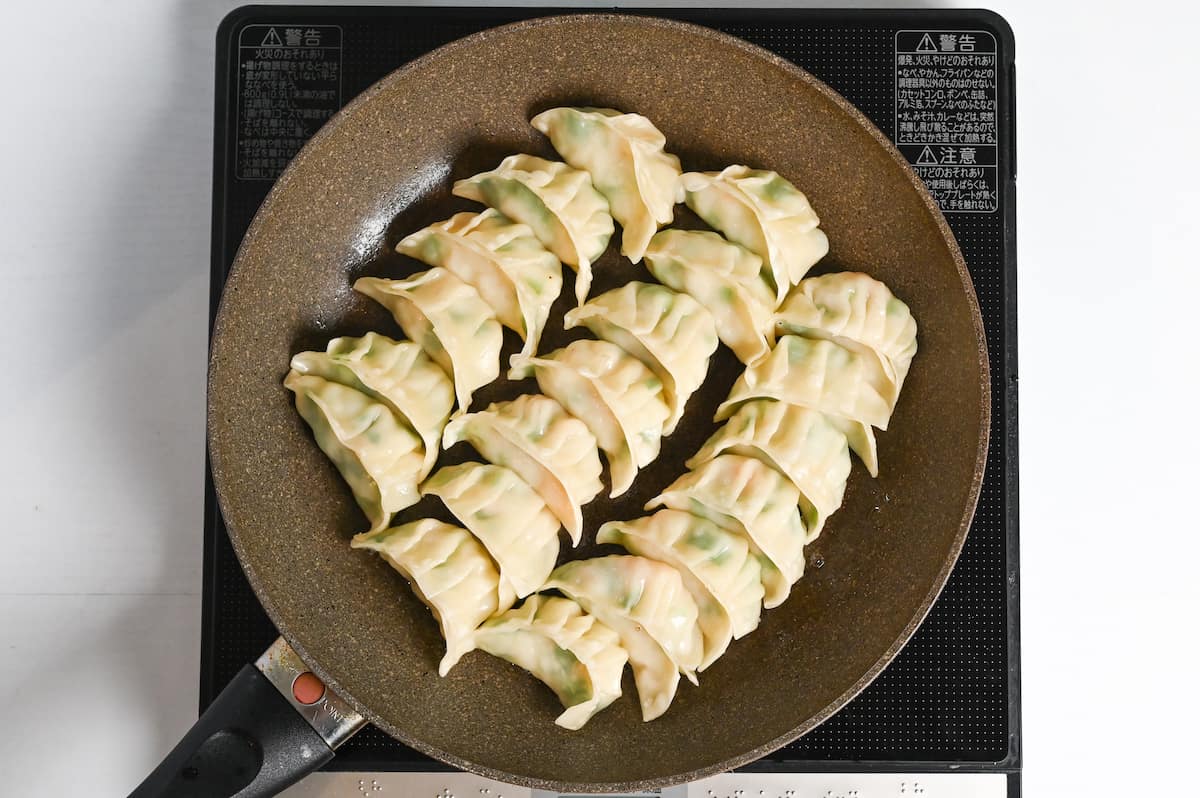
Thank you for this wonderful recipe! I used your gyoza wrapper recipe and also the shrimp filling…was a beautiful treat for a small dinner party appetizer! I found it quite hard to shape the gyoza though…and the pleats didn’t come out too nicely…but I think that will just take some practice – so I will make these more often!!!
The panfrying and then steaming turned out perfectly browned bottoms and soft tops! Pic is of the gyoza before cooking.
Hi radhaks,
Thank you for your comment! I’m really happy you tried both the filling and the wrappers! The pleats can definitely be a challenge, especially with homemade dough, but it gets easier the more you do it for sure! Your photo looks great — thanks for sharing your delicious work!
Yuto